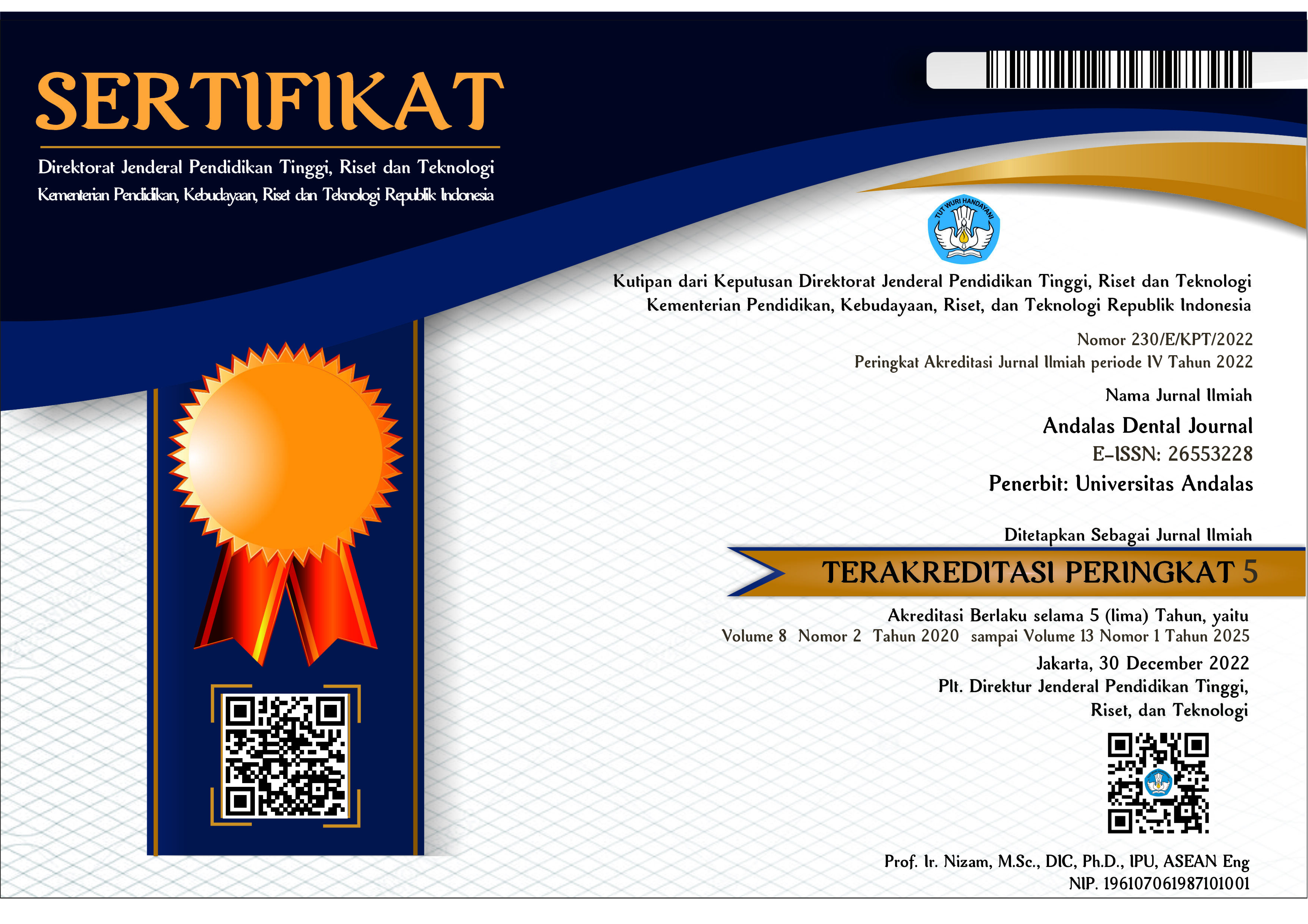Perbedaan Daya Hambat Obat Anestesi Lokal Lidocaine 2% dan Articaine 4% Terhadap Pertumbuhan Bakteri Porphyromonas Gingivalis Secara In Vitro
Abstract
Porphyromonas gingivalis is a gram-negative anaerobic bacteria which is an oral normal microflora located in subgingival area.This bacteria can cause inflamation and delayed wound healing after dental invasive procedures. Lidocaine 2% and articaine 4% are the most used anaesthetic agents in dentistry. Both of these agents have been studied for having antibacterial effect in certain concentrations. This will open the possibility of using local anaesthetic agents as antibacterial agent in dental invasive procedures to prevent infection after procedures. The purpose of this study is to analyze the difference inhibition of local anaesthetics drug lidocaine 2% and articaine 4% on the growth of Porphyromonas gingivalis bacteria in vitro. The study subject was pure culture of Porphyromonas gingivalis ATCC 33277 divided by two group, one group with lidocaine 2% and other with articaine 4%. This study was experimental laboratory with post test only control group design. The mean of inhibitions were obtained by measuring inhibition zone formed around paper discs with caliper in milimeter scale. The result showed Inhibition rate lidocaine 2% had greater rate than articaine 4% in inhibiting the growth of Porphyromonas gingivalis bacteria in vitro.The conclusion was lidocaine 2% was more effective than articaine 4% in inhibiting the growth of Porphyromonas gingivalis bacteria in vitro.
References
2. Riawan L. Penanggulangan Komplikasi Pencabutan Gigi. Makalah Pada Pembinaan Peningkatan Dokter Gigi Melalui Quality Assurance. Bandung : FKG UNPAD. 2002.
3. Li X, Kolltveit KM, Tronstad L, Olsen I. Systemic diseases caused by oral infection. Clin Microbiol Rev . 2000 Oct 1; 13(4): 547-58.
4. Heimdahl AN, Hall G, Hedberg M, Sandberg H, Söder PO, Tuner K, Nord CE. Detection and quantitation by lysis- filtration of bacteremia after different oral surgical procedures. J Clin Microbiol. 1990 Oct 1; 28(10): 2205-9.
5. Suzuki N, Yoneda M, Hirofuji T. Mixed red-complex bacterial infection in periodontitis. Int J Dent. 2013 Mar 6; 2013.
6. da Silva-Boghossian CM, do Souto RM, Luiz RR, Colombo AP. Association Of Red Complex, A. Actinomycetemcomitans And Non-Oral Bacteria With Periodontal Diseases. Arc Oral Biol. 2011 Sep 30; 56(9): 899-906.
7. Bhattacharya R, Xu F, Dong G, Li S, Tian C, Ponugoti B, Graves DT. Effect of Bacteria On the Wound Healing Behavior of Oral Epithelial Cells. PloS one. 2014 Feb 21; 9(2): e89475.
8. Li L, Messas E, Batista EL, Levine RA, Amar S. Porphyromonas gingivalis infection accelerates the progression of atherosclerosis in a heterozygous apolipoprotein E–deficient murine model. Circulation. 2002 Feb 19; 105(7): 861-7.
9. Tong DC, Rothwell BR. Antibiotic prophylaxis in dentistry: a review and practice recommendations. J Am Dent Assoc. 2000 Mar 31; 131(3): 366-74.
10. Lockhart PB, Loven B, Brennan MT, Fox PC. The evidence base for the efficacy of antibiotic prophylaxis in dental practice. J Am Dent Assoc. 2007 Apr 30; 138(4): 458- 74.
11. Scarlett MI. Local Anesthesia in Today's Dental Practice. Provider. 2010; 501: 211886.
12. Gmyrek R, Ratner D, Butler DF, Albertini JG, Quirk C, Elston DM. Local Anesthesia and Regional Anesthesia. Medscape: Updated Juli 07, 2015. URL http://www.emedicine.com/emerg/topic38 3.htm
13. Ikhsan M, Mariati NW, Mintjelungan C. Gambaran Penggunaan Bahan Anestesi Lokal Untuk Pencabutan Gigi Tetap Oleh Dokter Gigi Di Kota Manado. e-GIGI. 2013;1(2).
14. Darawade DA, Kumar S, Budhiraja S, Mittal M, Mehta TN. A Clinical Study of Efficacy of 4% Articaine Hydrochloride Versus 2% Lignocaine Hydrochloride in Dentistry. Int J Oral Health: JIOH. 2014 Sep; 6(5): 81.
15. Kumar MS. Efficacy of Articaine over Lidocaine–A Review. J Pharm Sci & Res Vol. 7(11), 2015, 956-959.
16. Malamed SF, Gagnon S, Leblanc D. A comparison between articaine HCl and lidocaine HCl in pediatric dental patients. Pediatrics Dent. 2000 Jul;22(4):307-11.
17. Johnson SM, Saint John BE, Dine AP. Local Anesthetics as Antimicrobial Agents: A Review. Surgical infect. 2008 Apr 1; 9(2): 205-13.
18. Kaya K, Rota S, DOĞAN B, Kökten G, Günaydin B, Bozdayi G. Comparison of The Antibacterial Effects of Two Local Anesthetics: Lidocaine and Articaine. Tr J Med Sci. 2007 Mar 14; 37(1): 7-10
19. Bahl R. Local Anesthesia in Dentistry. Anesthesia progress. 2004;51(4):138.
20. Geoffrey L. Howe, F. Ivor, H. Whitehead., Anestesi Lokal. 3rd Ed. Jakarta: Hipokrates. 1997.
21. Mysak, J., Podzimek, S., Sommerova, P., Lyuya-Mi, Y., Bartova, J., Janatova, T., Porphyromonas gingivalis Major periodontopathic pathogen overview. J Immunol, 2014, pp. 1-8.
22. Kusumawardani, B., Pujiastuti, P., Sandra D.S., Uji biokimiawi sistem API 20. 2010.
23. Coyle MB. Manual of antimicrobial susceptibility testing. American Society for Microbiol; 2005. 39-52.
24. Gilman AG, Rall TW, Nies AS, Taylor PG. Gilman’s the pharmacological basis of therapeutics.
25. Dahlan, M. S., Besar Sampel Dalam Penelitian Kedokteran. Arkans, Jakarta, 2006, pp. 19-70.
26. Mulyani Y, Bachtiar E, A Untung. Peranan Senyawa Metabolit Sekunder Tumbuhan Mangrove Terhadap Infeksi Bakteri Aeromonas hydrophila Pada Ikan Mas (Cyprinus carpio L.). J Akuatika. 2013.















